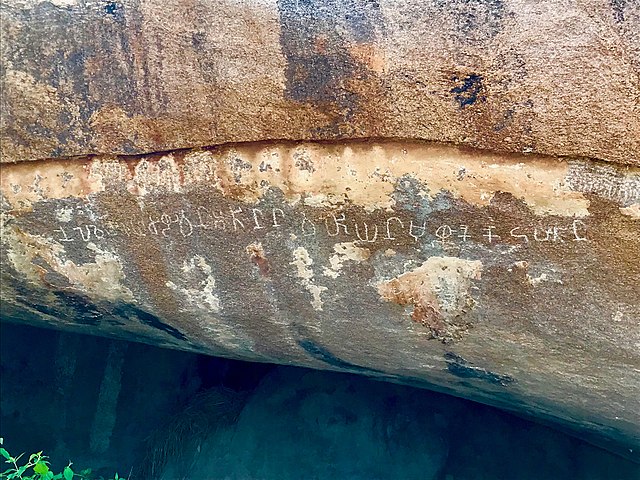Old Tamil is the period of the Tamil language spanning from 300 BCE to 700 CE. Prior to Old Tamil, the period of Tamil linguistic development is termed as Pre Tamil. After the Old Tamil period, Tamil becomes Middle Tamil. The earliest records in Old Tamil are inscriptions from between the 3rd and 1st century BCE in caves and on pottery. These inscriptions are written in a variant of the Brahmi script called Tamil Brahmi. The earliest long text in Old Tamil is the Tolkāppiyam, an early work on Tamil grammar and poetics, whose oldest layers could be as old as the mid 2nd century BCE. Old Tamil preserved many features of Proto-Dravidian, the earliest reconstructed form of the Dravidian including inventory of consonants, the syllable structure, and various grammatical features.The Satavahanas also issued bilingual coins featuring Middle Indo-Aryan language on one side, and Desi language on the other side.

A 2nd-century BCE Tamil Brahmi inscription from Arittapatti, Madurai India. The southern state of Tamil Nadu has emerged as a major source of Brahmi inscriptions in Old Tamil dated between 3rd to 1st centuries BCE.
Tamil is a Dravidian language natively spoken by the Tamil people of South Asia. Tamil is an official language of the Indian state of Tamil Nadu and union territory of Puducherry, and the sovereign nations of Sri Lanka and Singapore. Tamil is also spoken by significant minorities in the four other South Indian states of Kerala, Karnataka, Andhra Pradesh and Telangana, and the Union Territory of the Andaman and Nicobar Islands. It is also spoken by the Tamil diaspora found in many countries, including Malaysia, Myanmar, South Africa, United Kingdom, United States, Canada, Australia, New Zealand, United Arab Emirates, Saudi Arabia, France, Germany, Italy, Indonesia, and Mauritius. Tamil is also natively spoken by the Sri Lankan Moors. One of 22 scheduled languages in the Constitution of India, Tamil was the first to be classified as a classical language of India.
Findings from Adichanallur in the Government Museum, Chennai
Keezhadi excavation site
Explanation for Mangulam Tamil Brahmi inscription in Mangulam, Madurai district, Tamil Nadu, dated to Tamil Sangam period (c. 400 BC – c. 200 AD)
Tamil Brahmi script in the reverse side of the bilingual silver coin of king Vashishtiputra Sātakarni (c. AD 160) of Deccan. Rev: Ujjain/Sātavāhana symbol, crescented six-arch chaitya hill and river with Tamil Brahmi script Obv: Bust of king; Prakrit legend in the Brahmi script





